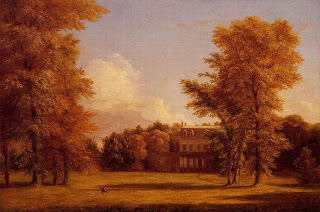| | |
| Born | February 1, 1801 Bolton, Lancashire, England |
| Died | February 11, 1848 (aged 47) Catskill, New York |
| Nationality | English |
| Field | painting |
| Movement | Hudson River School |
| Works | |
| Influenced | Asher B. Durand and Frederic Edwin Church |
Thomas Cole (February 1, 1801 - February 11, 1848) was a 19th century American artist. He is regarded as the founder of the Hudson River School, an American art movement that flourished in the mid-19th century. Cole's Hudson River School, as well as his own work, was known for its realistic and detailed portrayal of American landscape and wilderness, which feature themes of romanticism and naturalism.
Early life and education
He was born in Bolton, Lancashire, England. In 1818 his family emigrated to the United States, settling in Steubenville, Ohio, where Cole learned the rudiments of his profession from a wandering portrait painter named Stein. However, he had little success painting portraits, and his interest shifted to landscape. Moving to Pittsburgh in 1823 and then to Philadelphia in 1824, where he drew from casts at the Pennsylvania Academy of the Fine Arts, he rejoined his parents and sister in New York City early in 1825.
Painting
In New York he sold three paintings to George W. Bruen, who financed a summer trip to the Hudson Valley where he visited the Catskill Mountain House and painted the ruins of Fort Putnam.[1][2] Returning to New York he displayed three landscapes in the window of a bookstore; according to the New York Evening Post,[3] this garnered Cole the attention of John Trumbull, Asher B. Durand, and William Dunlap. Trumbull was especially impressed with the work of the young artist and sought him out, bought one of his paintings, and put him into contact with a number of his wealthy friends including Robert Gilmor of Baltimore and Daniel Wadsworth of Hartford, who became important patrons of the artist.
Cole was primarily a painter of landscapes, but he also painted allegorical works. The most famous of these are the five-part series, The Course of Empire, now in the collection of the New York Historical Society and the four-part The Voyage of Life. There are two versions of the latter, one at the National Gallery in Washington, D.C., the other at the Munson-Williams-Proctor Arts Institute in Utica, New York.
Cole influenced his artistic peers, especially Asher B. Durand and Frederic Edwin Church, who studied with Cole from 1844 to 1846. Cole spent the years 1829 to 1832 and 1841-1842 abroad, mainly in England and Italy; in Florence he lived with the sculptor Horatio Greenough.
Catskills
After 1827 he maintained a studio at the farm called Cedar Grove in the town of Catskill, New York. He painted a significant portion of his work in this studio. In 1836 he married Maria Bartow of Catskill, a niece of the owner, and became a year-round resident. He died at Catskill on February 11, 1848. The fourth highest peak in the Catskills is named Thomas Cole Mountain in his honor.[4] Cedar Grove, also known as the Thomas Cole House, was declared a National Historic Site in 1999.[5]
Architecture work
Cole dabbled in architecture, a not uncommon practice at the time when the profession was not so codified. Cole was an entrant in the design competition held in 1838 to create a new state government building in Columbus, Ohio. His entry won third premium, and many contend that the finished building, a composite of the first, second and third place entries, bears a great similarity to Cole's entry.
See also
Selected works
| The Garden of Eden (1828) | |||
| L'Allegro (Italian Sunset) (1845) | Il Penseroso (1845) |
References
- ^ http://findarticles.com/p/articles/mi_m1026/is_5_166/ai_n8700481
- ^ http://hamiltonauctiongalleries.com/COLE-T25FP.JPG
- ^ http://hamiltonauctiongalleries.com/Cole.htm
- ^ Cedar Grove History
- ^ "History of Cedar Grove". The Thomas Cole National Historic Site. Retrieved on 2007-10-30.
External links
- Hiking Thomas Cole Mountain Catskill 3500 Club
- Cedar Grove - The Thomas Cole National Historical Site in Catskill, NY
- Find-A-Grave profile for Thomas Cole
- Works by Thomas Cole at the Cincinnati Art Museum
http://en.wikipedia.org/wiki/Thomas_Cole
Contents
- 1 Early life and education
- 2 Painting
- 3 Catskills
- 4 Architecture work
- 5 See also
- 6 Selected works
- 7 References
- 8 External links
Thomas Cole: The Course of the Empire (Destruction)
| The Course of the Empire - Destruction (Oil, 1836) |
| This is the fourth in Thomas Cole's "Course of the Empire" series. (Be sure to start at the first painting so that you can see how the sun rises and moves through the sky. The mountain in the background remains throughout, but in the foreground, there are considerable changes.) Here are the links to each of the paintings: First Painting - Second - Third - Fourth - Last Cole chose something from Byron to help describe this work: There is the moral of all human tales; 'This but the same reheasal of the past First Freedom, and then Glory: when that fails Wealth, vice, corruption |
Thomas Cole: The Course of the Empire (The Consummation of the Empire)
| The Course of the Empire - Consummation of the Empire (Oil, 1836) |
| This is the third in Thomas Cole's "Course of the Empire" series. (Be sure to start at the first painting so that you can see how the sun rises and moves through the sky. The mountain in the background remains throughout, but in the foreground, there are considerable changes.) Here are the links to each of the paintings: First Painting - Second - Third - Fourth - Last Cole chose something from Byron to help describe this work: There is the moral of all human tales; 'This but the same reheasal of the past First Freedom, and then Glory: when that fails Wealth, vice, corruption |
--

























Hiç yorum yok:
Yorum Gönder